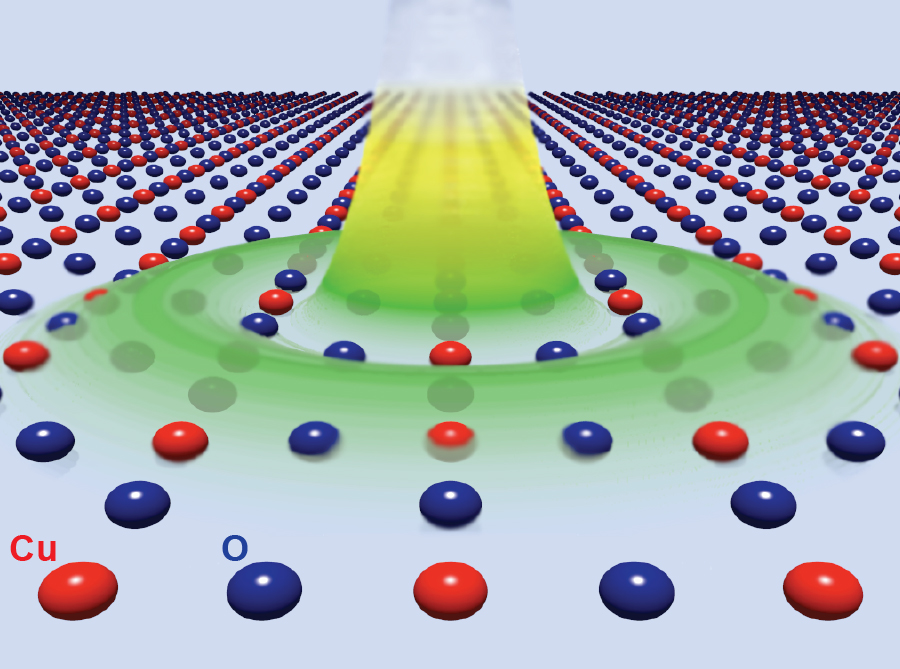Copperizing the Complexity of Superconductivity
Study suggests that how electrons interact in solids may be key to understanding the emerging phases of quantum materials
Published Date
By:
- Cynthia Dillon
Share This:
Article Content
From the perspective of a materials science physicist, a keen interest in copper oxides makes sense. The metallic compounds are versatile in their usefulness—from coins and antibacterials to spin dynamics and high-temperature superconductivity.
For a condensed matter expert like UC San Diego’s Alex Frano, the goal of high-temperature superconductivity is to move charge currents through a material without resistance and energy loss at easily attainable temperatures. This efficiency is necessary for low-power electronics and quantum technology. But the ultra-low temperatures required for traditional materials to be superconducting—hundreds of degrees below zero—is a major obstacle.

Pictorial representation of the Coulomb potential in the copper oxide plane. The Coulomb potential created by an electron at a copper site is non-monotonic at the length scale of a few lattice units due to a non-uniform polarizability that weakens the short-range electron-electron interactions. Image courtesy of Fabio Boschini, Institut national de la recherche scientifique.
While copper oxides are materials with the highest superconducting transition temperatures under normal conditions, physicists aren’t sure why. Frano, whose passion for physics is grounded in high-temperature superconductivity, believes this is a central problem. So while studying copper oxides recently, he and a group of research collaborators from the Max Planck Institute, Yale University, the University of British Columbia and UC Davis may have stumbled upon a major clue about how these metallic materials work. Their findings are published in Nature Communications and could help revolutionize our understanding of these superconductive materials.
Copper involves electrons engaging with other electrons through what’s called the electrostatic Coulomb interaction (when like charges repel and opposites attract). A ground state can emerge from this interaction and form a charge density—the amount of electrical charge per unit of length or surface area—which can modulate like waves in a sand dune. Running a sophisticated experiment using Resonant Inelastic X-ray Scattering (RIXS), a method that investigates the electronic structure of a material, the researchers observed how X-rays scattered off their sample, making their surprising discovery possible.
Frano explained that while charge density waves are known to propagate in two well-defined directions within a plane of the material, for example east-west and north-south, they observed fluctuating charge density waves propagating in all directions within the plane. This is because of the Coulomb interaction, which emanates in all directions.
“Nobody saw this coming,” said the assistant professor in the Department of Physics. “The Coulomb interaction governs most of the physical phenomena we have ever experienced. Most of the time, it is simple and monotonic—only consistently increasing or consistently decreasing as a function of distance between two separate charges. However, for electrons in solids, this can be non-monotonic because of the presence of other atoms.”
The study showed that the electrons moved in a medium of other atoms that could be polarized, meaning that under certain conditions electrons with the same charge could even attract. This general concept of how electrons in solids interact may be key to understanding the emerging electronic phases of strongly correlated quantum materials, such as heavy fermions, iron- and copper-based high-temperature superconductors and twisted bilayer graphene.
According to Frano, high-temperature superconductivity is a majestic manifestation of quantum mechanics emerging into something so surprising and beautiful that the origin of high-temperature superconductivity is among the most important questions in solid state physics.
“Not only because it could completely revolutionize the way energy is handled, but also because it is at the heart of one of the most fascinating kinds of materials called quantum materials,” said Frano. “What makes these interesting is that the rules of quantum mechanics govern their properties in a way that is completely unknown to all of us. They display a gamma of electronic phases like magnetism, charge density waves, and superconductivity all in the same material. And it is widely believed that the reason they are so rich in their properties is precisely why they are superconducting at such high temperatures. In other words, out of complexity comes more fascinating complexity.”
This study was supported by the U.S. Department of Energy ([DOE] grant no. DESC0012704); the Advanced Light Source, a DOE Office of Science User Facility (contract no. DE-AC02-05CH11231); the National Science Foundation (grant nos. 845994 and 2034345); JSPS KAKENHI (grant no. JP17H01052) and several other research facilities, foundations and institutes.
Share This:
You May Also Like
$10 Million Grant from Price Philanthropies Launches Behavioral Health Hub at UC San Diego Health
Health & BehaviorStay in the Know
Keep up with all the latest from UC San Diego. Subscribe to the newsletter today.



